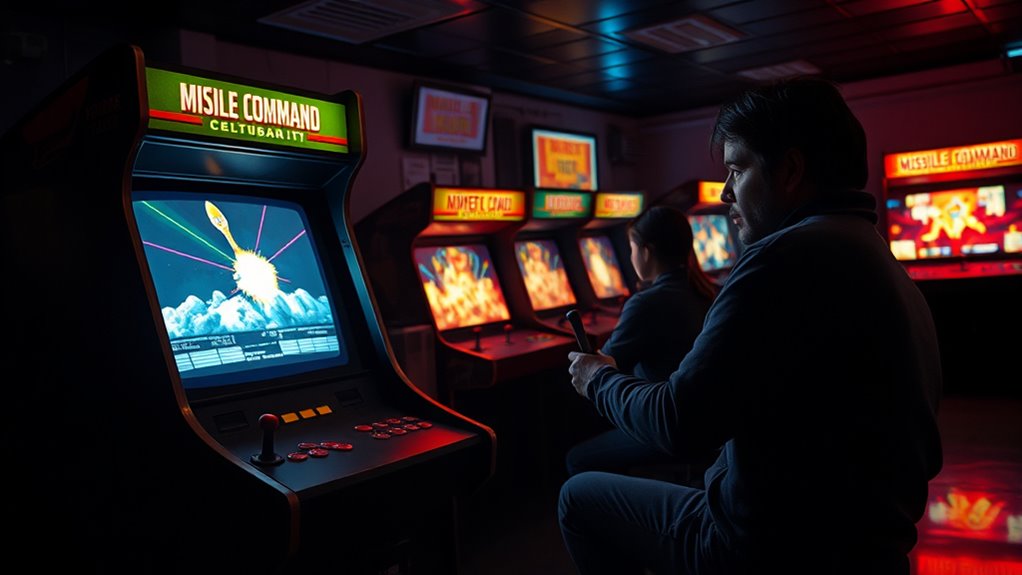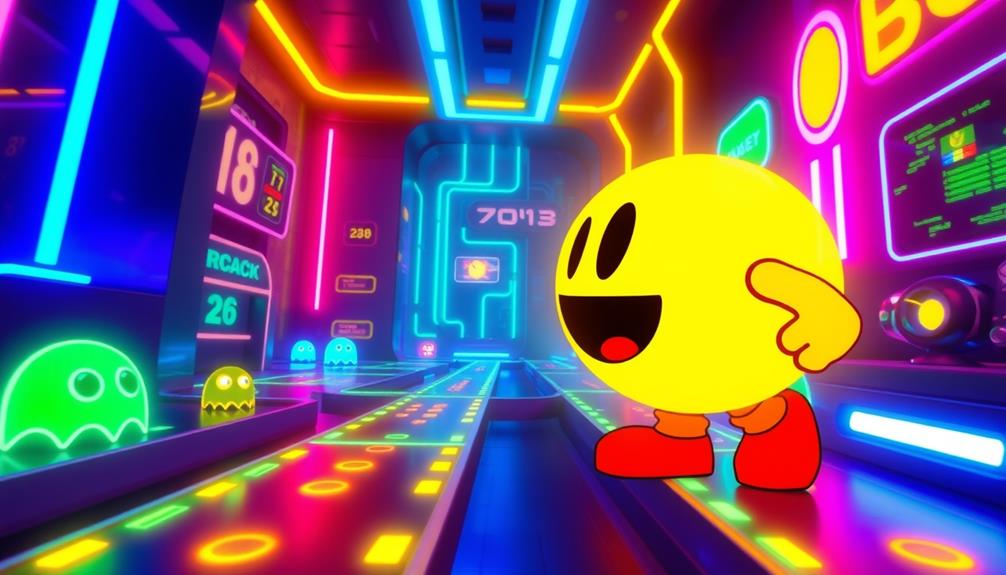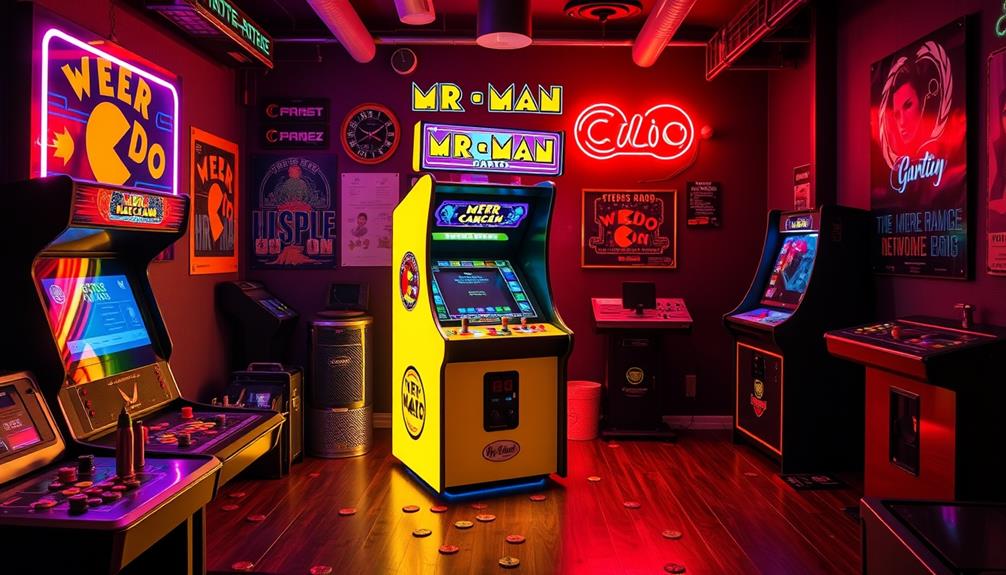Missile Command in arcades vividly reflects Cold War anxiety by immersing you in a relentless defend-and-survive game that symbolizes global nuclear fears. Its visuals of incoming missiles and exploding cities evoke societal fears of escalation and destruction, while the intense sounds heighten tension. The game’s themes of fragility and resilience mirror the tense atmosphere of the era, making players feel the collective nervousness. Continued exploration reveals how arcade games became cultural mirrors of Cold War fears and hopes.
Key Takeaways
- Missile Command’s missile defenses symbolize Cold War fears of nuclear escalation and societal vulnerability during arcade gameplay.
- The game’s visual and auditory chaos mirrors collective anxiety and the tense atmosphere of Cold War-era arcades.
- Its propaganda-inspired imagery and themes reflect societal tensions and the fragile balance of nuclear power.
- The arcade setting provided a communal space for society to confront and process fears of nuclear annihilation.
- Missile Command helped shape cultural perceptions of Cold War paranoia, embedding nuclear fears into gaming and collective memory.
The Rise of Arcade Culture During the Cold War
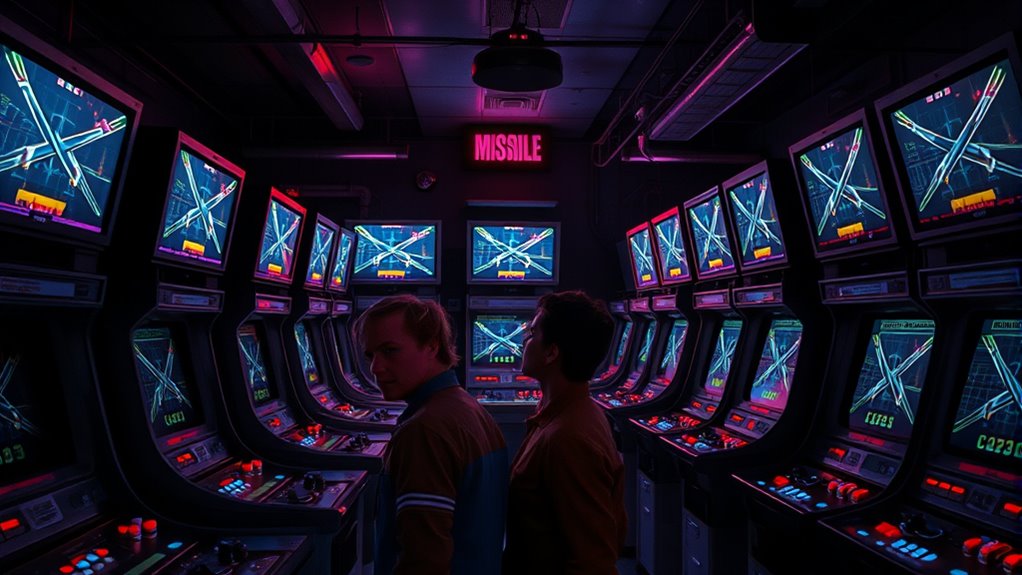
During the Cold War, arcade culture exploded in popularity as a form of entertainment that offered a thrilling escape from the looming threat of nuclear conflict. With nuclear paranoia gripping society, arcades became communal spaces where people could temporarily forget the fear of devastation. Many arcade games, including early shooting titles, subtly reflected propaganda messaging, emphasizing themes of defense and survival. These games capitalized on the era’s anxieties, turning the abstract threat of nuclear war into interactive challenges. As you played, you experienced a sense of empowerment and control, even amid societal unease. The rise of arcade culture was more than just entertainment; it was a response to the pervasive fears of the time, shaping how Americans coped with and processed Cold War tensions. The use of interactive gameplay allowed players to confront their fears in a controlled environment, transforming anxiety into a form of collective resilience.
Gameplay as a Reflection of Societal Tensions
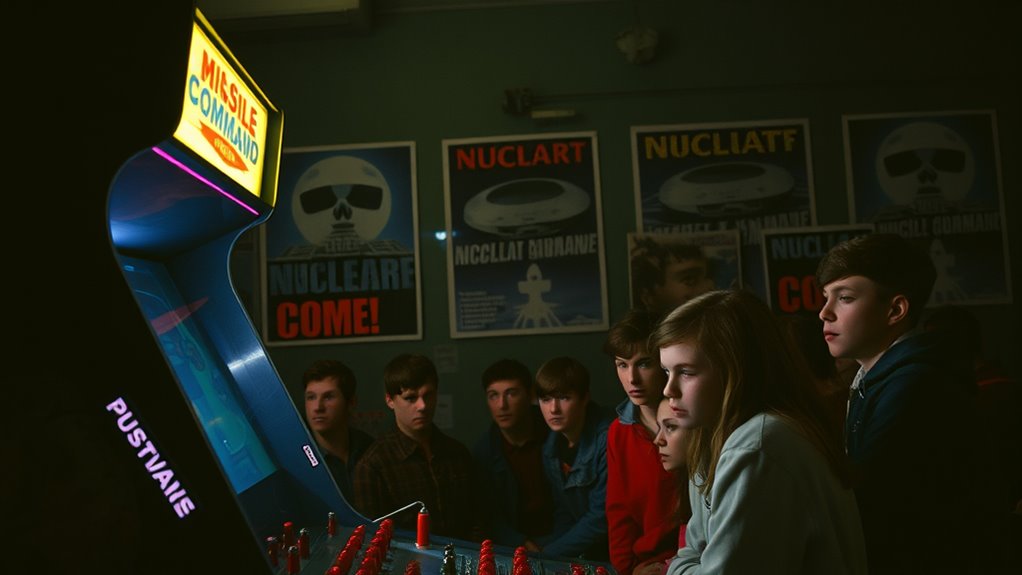
You can see how Cold War escalation is reflected in the visuals of Missile Command, with its exploding missiles and looming threats. The gameplay mechanics, like defending against relentless attacks, mirror the anxiety many felt during tense times. These elements serve as a direct reflection of societal fears surrounding nuclear conflict. Additionally, the game’s intense and strategic nature can be linked to broader personality traits such as resilience and stress management, which influenced how individuals coped with Cold War tensions.
Cold War Escalation Visuals
The visuals in Missile Command vividly mirror the escalating fears of the Cold War era, with the game’s exploding missiles and burning cities symbolizing the pervasive anxiety about nuclear conflict. You see nuclear imagery everywhere, as cities are reduced to ash and chaos, reflecting society’s dread of annihilation. The game’s use of propaganda symbols, like the red, white, and blue shields, echoes patriotic appeals meant to rally support during tense times. These visuals serve as a stark reminder of the era’s tensions, turning abstract fears into immediate, visceral experiences. By immersing you in a world of destruction, Missile Command captures the underlying societal unease about nuclear escalation, making the game a reflection of Cold War anxieties embedded in Cold War-era imagery. Additionally, the game’s imagery and themes foster active listening and empathy by immersing players in the emotional landscape of the era’s fears.
Anxiety in Gameplay Mechanics
The gameplay mechanics of Missile Command embed a visceral sense of tension that reflects societal anxieties about nuclear war. As you defend cities from incoming missiles, the game heightens stress through haptic feedback, making each near-miss feel immediate and personal. Difficulty scaling intensifies the experience by progressively increasing missile speed and attack frequency, mirroring the escalating threat of nuclear conflict. This design keeps you on edge, reinforcing feelings of vulnerability and urgency. The constant need for rapid, precise responses creates a cycle of heightened alertness, echoing Cold War fears of unpredictable escalation. Moreover, the game’s use of interactive gameplay immerses players in a high-stakes environment, transforming societal tension into tangible gameplay, emphasizing the precarious balance between security and catastrophe that defined the era.
Societal Fear Reflections
Gameplay mechanics in Missile Command serve as a mirror for societal fears during the Cold War, translating collective anxieties into tangible actions. As you defend cities from nuclear missiles, you embody the societal anxiety rooted in nuclear paranoia. The game reflects the tension between destruction and survival, echoing fears of an unstoppable nuclear conflict. This interplay creates a shared experience, making players feel the weight of Cold War fears firsthand. Below is a table illustrating how societal fears are embedded in gameplay:
| Cold War Fears | Missile Command Response |
|---|---|
| Nuclear Paranoia | Defending cities from missiles |
| Societal Anxiety | Urgency to prevent disaster |
| Escalating Tensions | Increasing missile attacks |
| Global Conflict | The game’s relentless pace |
Additionally, the game’s escalating difficulty mirrors the arms race mentality that characterized Cold War geopolitics.
Visual and Audio Elements Conveying Anxiety
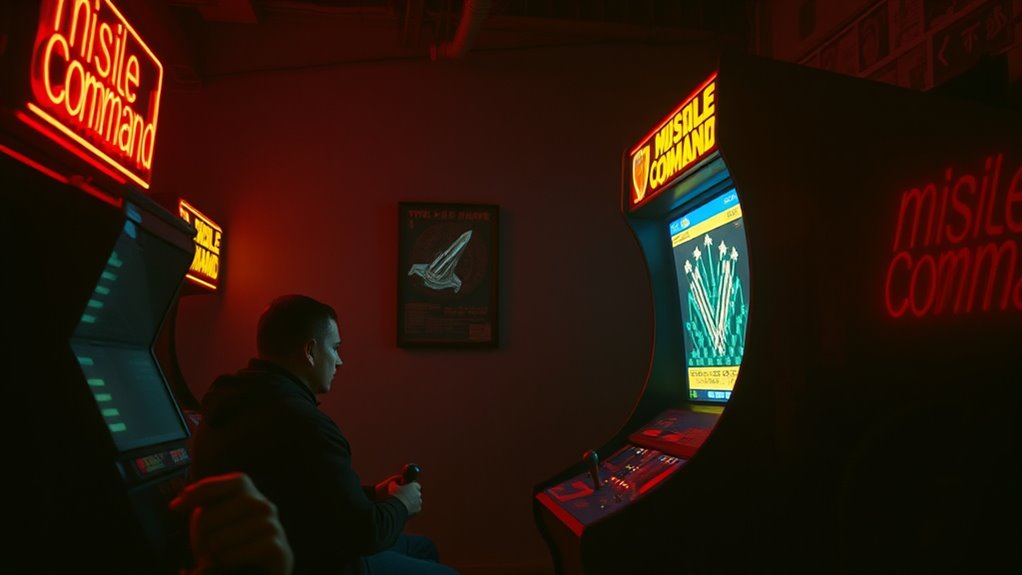
Visual and audio elements in Missile Command work together to create a tense, urgent atmosphere that heightens your anxiety. The synthesized soundscapes evoke a constant sense of alarm, with shrill alarm bells and rapid beeping that signal imminent danger. Visually, the screen erupts in chaos:
The intense visuals and shrill alarms in Missile Command heighten anxiety and immerse players in urgent chaos.
- Rapidly falling missiles blot out the background, creating visual chaos.
- Exploding cities flash brightly, emphasizing destruction.
- Your defensive structures flicker under attack, heightening tension.
- The score’s loud, pulsing tone rhythmically drives your sense of urgency.
These elements combine to immerse you in a climate of impending catastrophe, mirroring Cold War fears. The synthesized soundscapes intensify the chaos, making every missile launch feel personal and threatening. Sound design plays a crucial role in shaping this emotional response, amplifying the atmosphere of relentless anxiety.
Symbolism and Themes in Missile Command
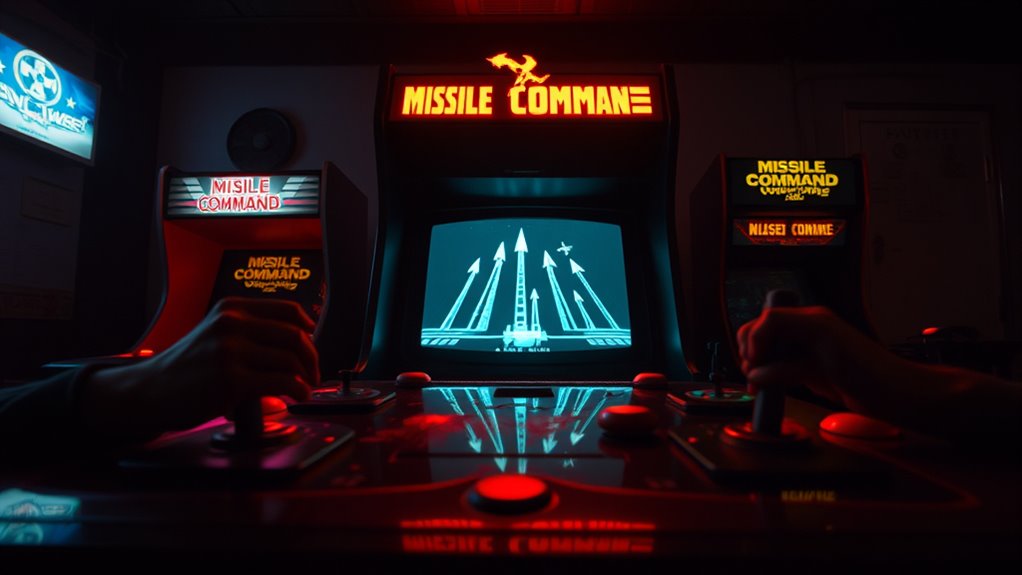
Missile Command serves as a powerful allegory for Cold War fears, using its themes and symbols to reflect the anxiety of nuclear conflict. The game’s nuclear symbolism, like incoming missiles and city destruction, visually represents the threat of nuclear annihilation. Its imagery creates a sense of paranoia, emphasizing fragility and vulnerability in the face of global catastrophe. The scattered missile launches and imminent destruction evoke a world on edge, mirroring societal fears of escalation and uncontrollable escalation of war. The game’s themes underscore the delicate balance of power and the consequences of nuclear proliferation. You’re not just defending cities; you’re confronting the terrifying reality of potential global destruction, making Missile Command a vivid reflection of Cold War paranoia and the pervasive dread of nuclear conflict. Understanding IRA taxes can help contextualize how governments manage the economic fallout from such crises.
Player Experience and Collective Nervousness

As you navigate through Missile Command’s frantic defenses, a sense of collective anxiety pervades the experience, mirroring societal fears of nuclear war during the Cold War era. Your player psychology becomes intertwined with a shared consciousness, amplifying the tension. You feel:
- The mounting pressure as missiles multiply rapidly, testing your reflexes and focus.
- An unspoken connection with other players, united in a common struggle.
- The rising stress as the screen fills with explosions, symbolizing collective vulnerability.
- A sense of urgency that echoes societal fears, making each shot feel like a stand against catastrophe.
- The protective styling benefits of engaging with such intense gameplay, as players seek to shield their mental well-being from overwhelming anxiety.
This shared nervousness heightens immersion, transforming a game into a reflection of Cold War-era collective consciousness, where individual actions symbolize broader societal anxieties.
Arcade Games as a Mirror of Cold-War Fears
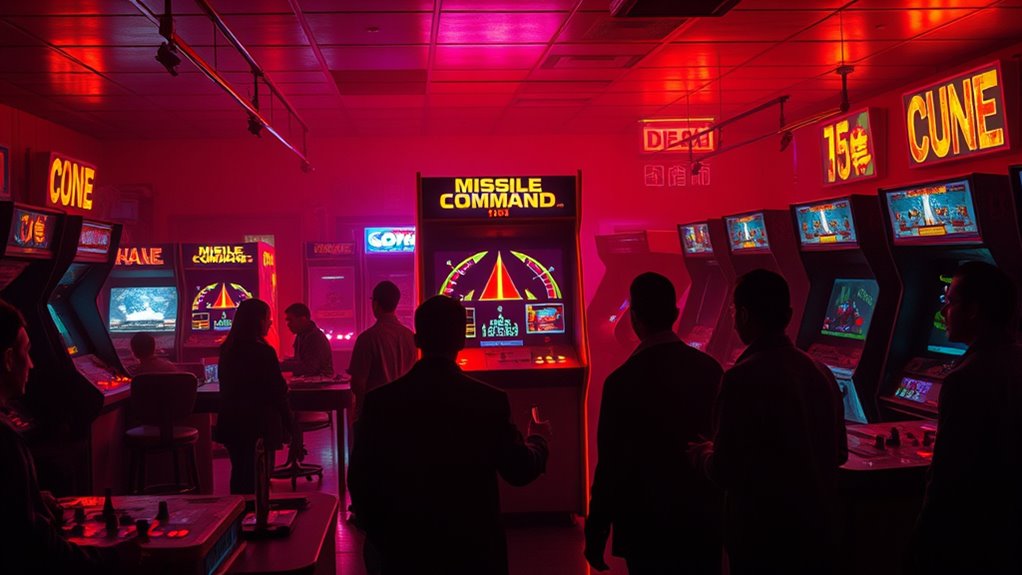
Arcade games during the Cold War era serve as powerful symbols of societal anxieties about nuclear conflict and global instability. You see, these games reflect nuclear paranoia by putting players in scenarios where defending against missile attacks feels urgent and real. Many titles incorporate espionage themes, highlighting fears of infiltration, sabotage, and covert operations that could escalate tensions. Through gameplay, you’re subtly engaging with the era’s collective dread of nuclear war and espionage threats. These games mirror the pervasive suspicion and uncertainty of the time, transforming abstract fears into interactive challenges. Interestingly, some games explicitly depicted nuclear missile scenarios, emphasizing the constant threat of nuclear annihilation faced during that period. By doing so, arcade games become not just entertainment but also a reflection of the deep-seated anxieties that defined Cold War society. They reveal how fears of nuclear annihilation shaped cultural perceptions and daily life.
Legacy and Cultural Impact of Cold-War Era Video Games
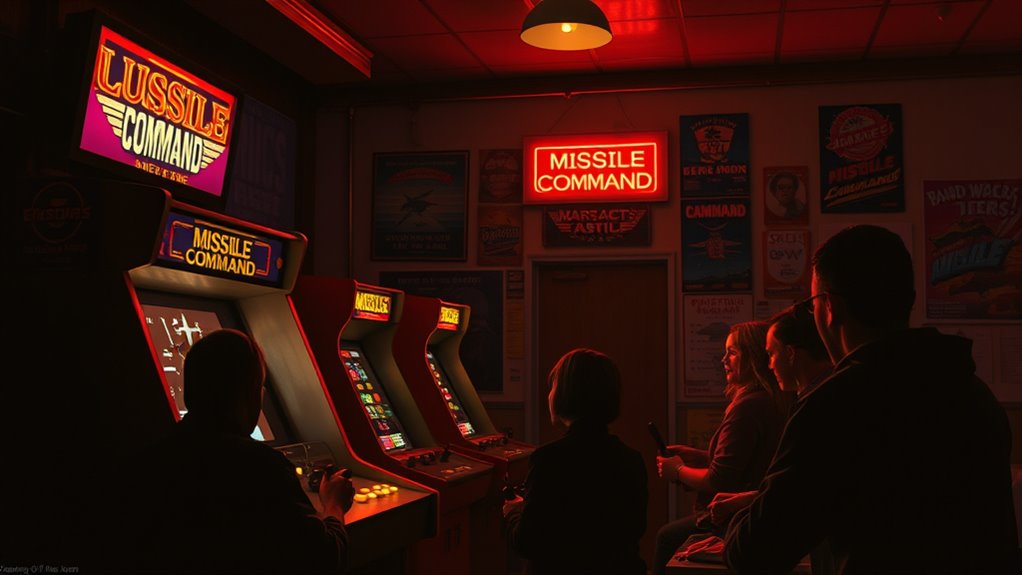
Cold War-era video games like Missile Command helped shape the mythos of that tense period, reflecting society’s fears and hopes. These games influence modern gaming culture and continue to serve as reminders of Cold War anxieties. Understanding their impact reveals how video games became a powerful cultural force beyond entertainment. Additionally, the themes and aesthetics of these games often drew inspiration from best anime movies, emphasizing themes of conflict and heroism that resonated with contemporary audiences.
Cold War Mythos
Cold War-era video games like Missile Command have left a lasting mark on cultural memory by immersing players in the anxiety and tensions of the nuclear age. They create a mythos rooted in nuclear paranoia and ideological conflict, shaping perceptions of global danger. Here’s what this mythos includes:
- A sense of imminent catastrophe, reinforcing fears of nuclear annihilation.
- The portrayal of superpower rivalry as a battle with no winners.
- The idea that technological advancements could both threaten and protect society.
- A narrative emphasizing resilience amid chaos, reflecting Cold War anxieties.
These elements embed themselves into the cultural fabric, transforming gameplay into a reflection of the era’s fears and ideological conflicts. You experience not just a game, but a mythic story of survival and global tension.
Video Game Influence
The mythos surrounding games like Missile Command didn’t just reflect Cold War anxieties—they also shaped the legacy of video games and their cultural impact. These games introduced a psychological impact by immersing players in the tension of nuclear threat, making the experience visceral and personal. They also became powerful technological symbolism, showcasing how arcade hardware could evoke intense emotions and simulate complex conflicts. This influence extended beyond entertainment, inspiring future game designers to explore themes of war, survival, and technological power. Cold-war era titles demonstrated that video games could serve as more than mere escapism—they could mirror societal fears and provoke reflection. As a result, they helped establish video games as a serious cultural medium, capable of addressing profound themes rooted in historical and psychological realities.
Frequently Asked Questions
How Did Missile Command Influence Public Perceptions of Nuclear Conflict?
You might think about how video games like Missile Command shaped public perception by making nuclear conflict feel more tangible. This game heightened nuclear anxiety, showing you how easy it was to lose everything in a nuclear attack. It influenced your view, making you more aware of the dangers and risks associated with Cold War tensions. As a result, your perception of nuclear conflict became more immediate and emotionally charged.
Were There Other Arcade Games Explicitly Designed to Depict Cold War Fears?
Ever wonder if arcade games doubled as Cold War propaganda? You bet! Games like “Defender” and “Nuclear War” used Cold War symbolism and arcade game design to mirror fears of nuclear conflict. They weren’t just for fun; they subtly reminded you of the tension and danger lurking in the background of everyday life. These games turned your joystick into a tiny soldier in the ongoing Cold War drama.
Did Players Recognize the Symbolic Themes During the Game’s Initial Release?
When you first played the game, you might not have immediately recognized its symbolic themes. Player awareness of these deeper messages often developed over time as you engaged more with the gameplay and context. During its initial release, many players focused on the challenge and excitement rather than symbolic recognition. However, as the Cold War’s anxiety grew, awareness of the game’s underlying themes increased, enriching the gaming experience with a layer of symbolic significance.
How Did Arcade Operators Respond to the Game’s Intense Themes?
You might think arcade operators ignored the game’s intense themes, but many implemented strategies like arcade censorship to soften its impact. They often adjusted screen displays or limited gameplay to make it less confrontational. These operator tactics aimed to balance attracting players with avoiding controversy. Investigating these strategies reveals that, rather than ignoring the themes, operators adapted their responses to maintain arcade popularity while managing societal sensitivities around Cold War anxieties.
What Was the Global Impact of Missile Command Beyond American Audiences?
You see that Missile Command’s international reception sparked cultural reinterpretations worldwide. As players in different countries engaged with its themes, they reflected on their own Cold War fears and anxieties. This game’s global impact extended beyond American audiences, influencing how people understood nuclear threats and military power. It became a symbol of Cold War tensions, prompting discussions and reactions across diverse cultures, shaping perceptions of war and technology worldwide.
Conclusion
As you played Missile Command, you felt the weight of Cold War fears in every shot and sound. You experienced the tension of impending disaster, the urgency of survival, and the anxiety of a world on edge. You recognized that arcade games reflected society’s collective fears, mirrored its hopes, and echoed its uncertainties. In this way, you saw how the game’s chaos and calm encapsulated a generation’s complex emotions—fear, resilience, and the desire for control.
